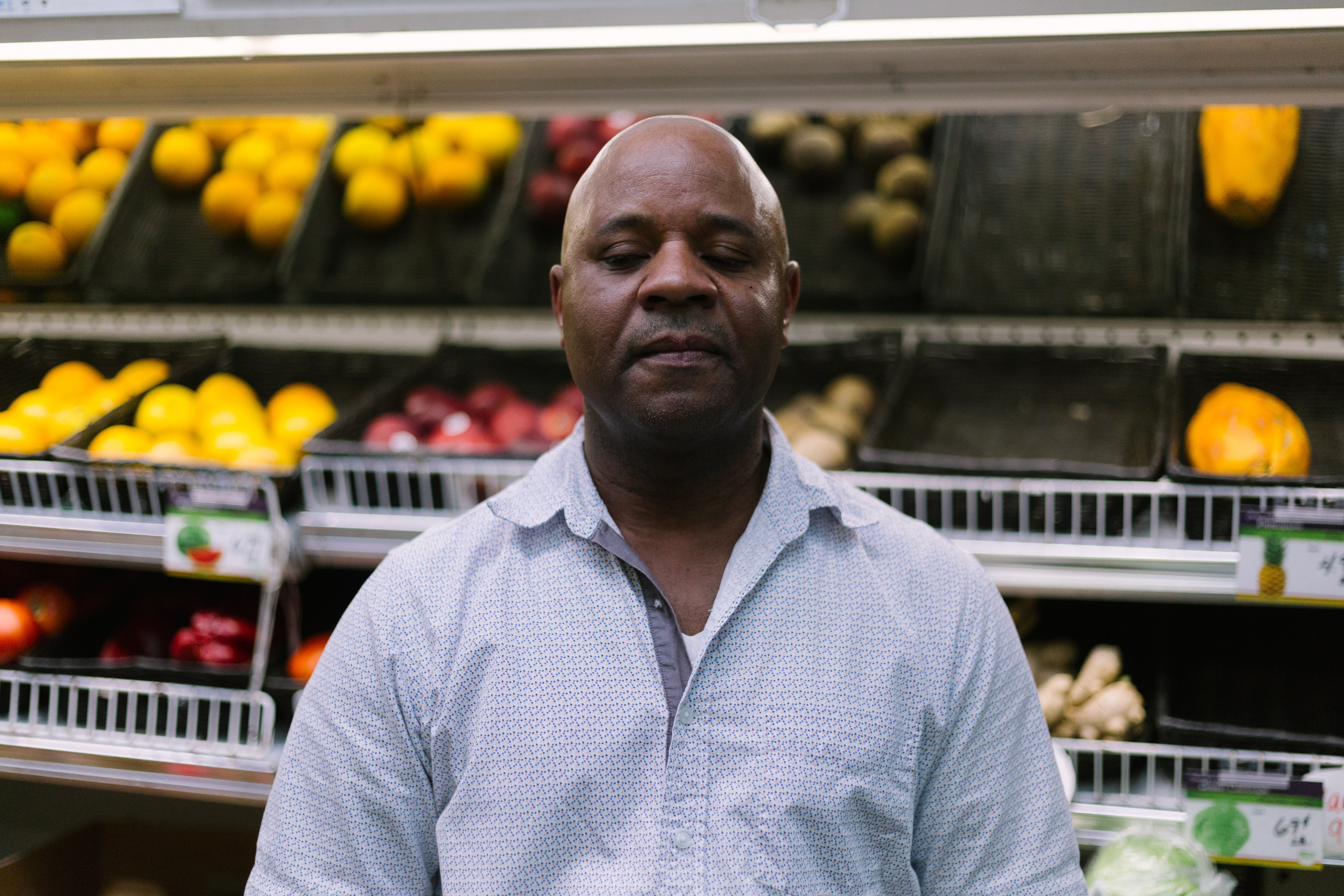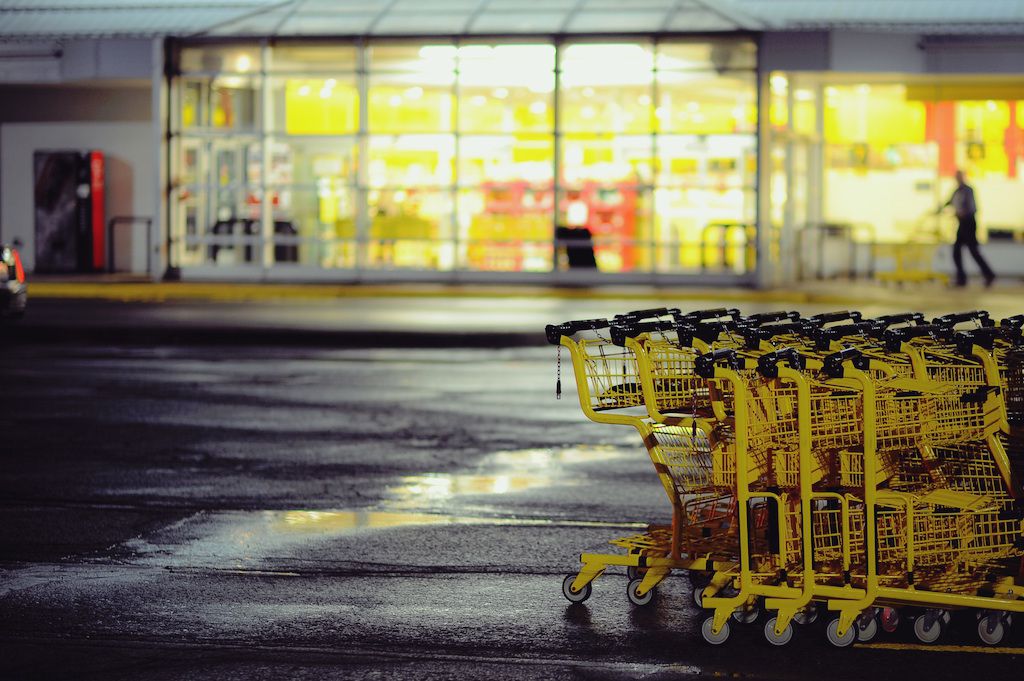
Derek Saffe
This piece was published in partnership with The Intercept.
In Washington Heights, a hilly neighborhood at the northern tip of Manhattan, 128 P&L Deli Grocery is the busiest hub on the block. Outside, neighbors lounge in lawn chairs and pass around a hookah hose. Inside, customers watch baseball on an iPhone mounted behind the counter and sip tamarind juice through straws. Yucca, plantains, and bagged heads of lettuce loiter by the entrance.
Porfirio Mejia, the Dominican-born New Yorker who has owned this grocery for six years, seems to know everyone. He pats a few kids on the head and nods when a woman tells him she’ll pay him tomorrow. He pauses to inspect the peppers and tomatoes, remarking that a fresh produce delivery is due the next day. He works with the anti-hunger advocacy organization City Harvest to promote fruit and vegetable purchases, and he says that more than half of his customers buy their groceries with SNAP, the government assistance program formerly known as food stamps.
Well, they used to. The SNAP transactions at P&L tripped the wires of an algorithm that the U.S. Department of Agriculture uses to screen for fraud. Mejia’s decision to issue IOU’s to his regular customers — a policy that allowed him to deliver food to elderly neighbors and settle up after they received their benefits — triggered a suspicious activity flag in the system. By allowing customers to rack up a few weeks’ worth of grocery bills before paying with their benefit cards, Mejia violated the agency’s rules, which prohibit retailers from establishing informal credit systems with their customers.
 Derek Saffe
Derek Saffe When Porfirio Mejia lost his SNAP customers, 35 to 40 percent of his income went with them
About a year ago, a USDA letter informed Mejia that he was suspected of defrauding the government, so he rushed to enlist more than 30 of his neighbors to write letters explaining that his credit system did not constitute fraud — trading cash for food stamps. When I visited P&L in May, a stack of handwritten letters still sat on Mejia’s desk, with receipts attached.
His efforts weren’t enough. The agency wanted itemized receipts for the purchases that had been flagged, but Mejia’s cash registers at the time printed only total sales figures; he couldn’t provide an accounting of the individual products that his clients had bought on credit. He was permanently banned from accepting food stamps. When he lost his SNAP customers, 35 to 40 percent of his income went with them. When we spoke in May, he said he’s had to cut down on employees’ hours, and started working 14- and 15-hour days. He’s thought about selling the store.
Mejia is hardly alone. Last year, the USDA disqualified more than 1,600 retailers across the country from receiving SNAP payments. Over 90 percent of those businesses are convenience stores or small groceries. And while some of them almost certainly engaged in the cash-for-food-stamps fraud that the system is designed to detect, many of them, like P&L, were probably unjustly caught in the crosshairs.
 Derek Saffe
Derek Saffe Mejia enlisted more than 30 of his neighbors to write letters explaining that his credit system did not constitute fraud—to no avail
It’s impossible to pin down exactly how many retailers were banned from accepting SNAP dollars due to fraud charges that the government can’t actually prove. But court testimony by a USDA official indicates that, just last year, hundreds of retailers were permanently disqualified from the program based primarily on an algorithmic assessment of their transaction patterns — the same circumstantial evidence that ensnared Mejia. “It’s a jerry-rigged system against small retailers unlike anything I’ve ever seen before,” said Stewart Fried, an attorney who has represented store owners flagged by the algorithm.
The USDA does not bother to justify or even explain the precise sales figures or thresholds that cause retailers to be flagged for investigation. In fact, officials appear not to know how they were developed in the first place. Douglas Edward Wilson, a USDA program analyst who has worked with the ALERT system for more than a decade, testified in a 2017 deposition that he had no idea who originally set the parameters for flagging fraudulent transactions.
 Derek Saffe
Derek Saffe Photographed here is Porfirio Mejia, whose small grocery in Washington Heights was wrongly charged with SNAP fraud
Mejia seems to have been disqualified from the SNAP program based almost entirely on the atypical transaction patterns identified by the algorithm. He said he was never asked to explain these patterns before he was charged with fraud, nor did the agency present him with any evidence that he had traded cash for food stamps. Once accused, he was expected to prove his own innocence and the odds were stacked against him.
His situation is not uncommon: Retailers are regularly issued letters alleging “unusual, irregular, and inexplicable SNAP activity” based on their transaction history. According to a deposition given by Gilda Torres, a USDA section chief who oversees disqualifications, algorithm-flagged stores referred to her office for investigation are issued charge letters more than 95 percent of the time. And once they’re charged, their chances of reversing the decision are close to zero.
After the charge letter is received, retailers have 10 days to submit evidence to prove their innocence, a process that rarely results in decision reversals. Torres oversees SNAP disqualifications in New England, Maryland, New Jersey, Delaware, and Washington, D.C. In her district, 100 percent of cases that landed on her desk resulted in permanent disqualification in 2015, 2016, and 2017.
 Derek Saffe
Derek Saffe In 2017, the USDA disqualified more than 1,600 retailers across the country from receiving SNAP payments—90 percent of those are convenience stores or small groceries
Businesses that do not successfully challenge the charge letter then have the option to seek administrative review of agency decisions, but that process is just as unforgiving. Of the 1,283 administrative reviews requested nationwide in 2017, only 20 disqualifications were reversed.
It’s a justice system that puts the burden of proof on the accused — and one in which most cases are decided long before they reach a courtroom. In the blink of an eye, the owners of small, neighborhood grocery stores can lose half their income.
When the Trump administration announced its half-baked proposal to replace some SNAP payments with pre-packaged “Harvest Boxes” in February, it justified the change in policy by claiming that it would help reduce food stamp fraud. But fraud plays a much larger role in the popular imagination than it does in the program itself.
The USDA estimated that fraud accounted for 1.5 percent of the roughly $70 billion in benefits the program administered, or about $1 billion, in 2014. By contrast, that same year the government misallocated 2.27 percent of total benefits simply by overpaying beneficiaries, according to the Center for Budget and Policy Priorities. Regardless, for each of the last three years, the agency appropriated more than $17 million to fight retailer fraud in the more than quarter million retail establishments that accept food stamps. (The USDA administers SNAP at the federal level.)
 Derek Saffe
Derek Saffe In order to appeal charges of SNAP fraud, the USDA demands itemized receipts for flagged purchases. But Mejia’s cash registers at the time printed only total sales figures
Before the agency fully transitioned to debit-style Electronic Benefit Transfer cards about 20 years ago, food stamp fraud was policed primarily using undercover agents. These agents watch for less serious program violations — like the sale of non-food items — and fraud, the exchange of cash for food stamps. A 2018 USDA request for information from potential government contractors provides a glimpse into how these investigations operate: Agents try to pass as a typical customer, then attempt to use EBT cards to purchase SNAP-ineligible items like sponges or cigarettes.
While the agency still uses these undercover agents — in 2017, it conducted 5,557 such investigations — they rarely find evidence of fraud. Last year, less than 6 percent of retail investigations found retailers engaging in actual fraud. (Less than half identified any program violations at all, even minor ones.)
The introduction of EBT cards provided a new way for the USDA to detect potentially fraudulent behavior: It could digitally monitor all transactions in real time and screen for patterns suggesting irregularities. The agency commissioned the development of an algorithm, dubbed the ALERT system, that is used in many SNAP fraud cases today.
 Derek Saffe
Derek Saffe The introduction of EBT cards allowed the USDA to digitally monitor all transactions in real time and screen for patterns suggesting irregularities. However, this system also unjustly catches small businesses, like 128 P&L Deli Grocery, in its crosshairs
The ALERT system analyzes millions of SNAP transactions and assigns ratings to businesses based on the number of unusual transactions they process. Unusual transactions can include sales volumes that are much higher than those at neighboring stores, multiple withdrawals from the same card over a short period of time, multiple purchases that end in the same number of cents, or very frequent or large purchases.
It was the last of these that ensnared Mejia. His practice of letting customers purchase food on credit — which resulted in one-time payments of hundreds of dollars when they cleared their accounts — showed up in the system as an atypical pattern and initiated his disqualification from the program.
The USDA argues that the ALERT system is one tool among many in a thorough disqualification process. “When [the USDA] suspects a store may be committing SNAP violations, staff will carefully review the store information including SNAP redemptions, any history of complaints, the owner’s history in the program, and store visit records which include photos and details of the store and inventory,” a USDA spokesperson wrote in an email statement. “If, after review of all the information gathered, [agency] staff believe further investigation is warranted, they (not the ALERT system) will initiate a compliance review — which may include further investigative analysis or an undercover investigation — and if warranted, charge the store with violations.”
 Derek Saffe
Derek Saffe Mejia said he’s had to cut down on employees’ hours, and started working 14- and 15-hour days
Torres’s 2017 deposition tells a different story. The USDA section chief testified that the “investigative analysis” referenced in the agency’s emailed statement is based primarily on ALERT data. And there’s little leeway if a grocer is deemed to have violated the rules: According to decisions posted to the agency’s own website, retailers can be disqualified with no prior violations and decades of successful participation in the program.
Raul Barrios, a senior healthy retail specialist at the anti-hunger advocacy group City Harvest, spends most of his time visiting small New York City groceries to encourage proprietors to stock fruits and vegetables. He said he regularly encounters retailers who have been permanently disqualified from SNAP and appear to have inadvertently tripped the ALERT system’s wires through normal business activities that stop short of fraud. He cited stores like Mejia’s, which allowed customers to buy food on credit, and said that the multiple withdrawals flag could be triggered by neighbors who drop in for a gallon of milk in the morning and a bottle of water later in the day.
“In family-owned businesses that are pillars of the community, people go numerous times,” he said, adding that convenience store owners’ tendency to round prices to the nearest 50 cents likely triggers the same-cents flag. “A lot of them are not aware of the laws, of the do’s and the don’t’s.”
Barrios said he thinks up to half of retailers disqualified based on algorithmic evidence did not actually commit fraud. After all, credit systems like Mejia’s look the same on paper as the kind of cash-for-benefits scenario the government wants to stamp out.
Once a retailer receives a charge letter, they have 10 days to appeal the ruling by submitting proof that their transactions are all legitimate. (According to a USDA spokesperson, retailers can request extensions.) Last year, only 4 percent of retailers nationwide succeeded in reversing the decision during this stage.
 Derek Saffe
Derek Saffe Yucca and plantains loiter by the entrance of 128 P&L Deli Grocery
Then, retailers have another opportunity to appeal during a process called “administrative review.” Reversal rates at this stage are even lower. For people like Mejia, who had no way of knowing that he needed to be saving itemized receipts, it’s an uphill battle. According to documents posted to the USDA’s website, retailers send a wide variety of paperwork to prove their innocence: medical records that show transactions flagged as fraudulent happened while owners were taking care of a sick family member, proof that employees had been trained in SNAP policy, credit logs, and in some cases hundreds of pages of receipts and letters from customers. Torres, the USDA section chief, testified that her region did not overturn any of its decisions in the last three years based on retailer-provided evidence during the administrative review period.
“[Retailers] lose almost 100 percent of the time because they don’t know what they’re doing, don’t know what [the USDA] is looking for,” said Fried, the lawyer.
According to Mejia, no one from the USDA ever called him to explain the appeals process. He does remember someone from the agency coming to his store before he received his charge letter, but that person only took pictures and didn’t initiate a conversation.
In Torres’s 2017 testimony for a separate SNAP case in Maryland, she said stores are initially inspected by agency contractors — sometimes months before a charge is issued — to measure square footage and look at inventory. These visits generate a sort of in-store snapshot for USDA staff members to cross-reference with ALERT system findings, and contractors aren’t tasked with finding hard evidence of fraudulent behavior. Torres said agency staff don’t typically visit retailers at any point in the disqualification process.
 Derek Saffe
Derek Saffe For now, Mejia is moving on. Still, he doesn’t think accepting credit is the same thing as trading cash for food stamps
Mejia thought about retaining a lawyer but decided it would be too expensive. Had he sought legal advice, he might have discovered that there is one avenue for redress beyond the initial appeal and administrative review: judicial review of the decision, which means a trip to federal court. “At that point, the playing field gets leveled remarkably,” Fried said, adding that this process gives retailers access to the USDA’s full records and allows their lawyers to take depositions.
But legal representation can be expensive, and Barrios said small retailers are often skeptical that lawyers are worth the cost. The USDA doesn’t provide data on how many cases go to judicial review, but according to Fried, the number is almost certainly very small.
In other words, once retailers are accused, their chances of successfully proving their innocence are vanishingly slim. “That’s a big problem, when 100 percent of the retailers in all of New England, Jersey, Maryland, and D.C. are convicted based on a case that’s largely circumstantial,” Fried said, referring to Torres’s decision record since 2015. “The only hard evidence is a snapshot 30-minute visit [a USDA] contractor does, going out to the property one time to look around it.”
For now, Mejia’s moving on. He says he knows he broke the rules by allowing customers to buy on credit, and he accepts the agency’s decision to permanently disqualify him from SNAP. Still, he doesn’t think accepting credit is the same thing as trading cash for food stamps. And he thinks others have found themselves in the same boat, denied badly needed revenue simply for providing a service they see as neighborly. “It’s a system small business owners don’t understand,” he says in Spanish.










